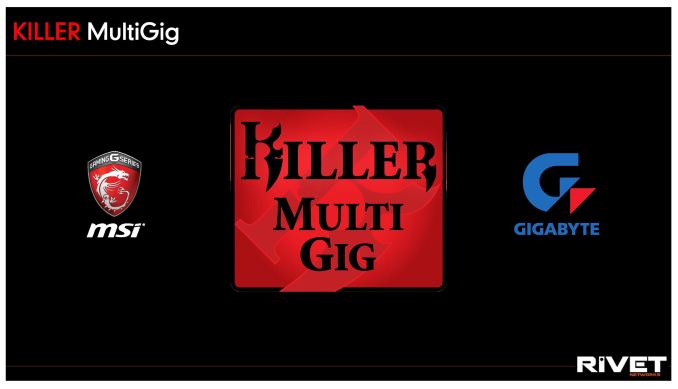Rivet Networks Announces Killer Support for 10 Gbps Network Controllers
by Ian Cutress on May 30, 2017 1:30 AM EST
As part of several announcements today, Rivet Networks (the company behind the Killer branded network controllers, and formerly a brand under Qualcomm) is starting their Computex news with software support for upcoming platforms featuring multi-gigabit technologies. In the past few months we have seen network controllers, such as those from Aquantia, supporting new multi-gigabit standards, such as 2.5G and 5G, in a single chip (and some chips support 10G as well). In order to propagate the Killer networking infrastructure moving forward, Rivet is working with their motherboard partners to offer Killer-based software solutions on top of these new multi-gigabit controllers. To start this is a fully software-enabled enterprise tightly coupled to the motherboard vendors and certain multi-gigabit chipsets, but we were told to expect hardware solutions from Killer in the future (time-scale is TBD).
We discussed with Rivet Networks about the software solutions, which will allow users to prioritize traffic and take advantage of lower ping/fewer freezes when the network is being saturated from the same machines, compared to the current hardware solutions available. When using their own silicon and controller, Rivet stated that they are able to do more, offload more, and implement more features without impacting system performance. The software solution does a number of similar things, but it’s not complete. That being said, the venture into supporting certain multi-gigabit chipsets such as the Aquantia ones is a step forward into preparing for their own silicon. It should be noted that the collaboration is more at the motherboard manufacturer level rather than the silicon level, so Rivet has had to peel through documents and test the supported chipsets to see what features they can offer.
In discussions with Aquantia, we are expecting to see more vendors offer the AQtion solutions over the coming months, especially with the launch of several high-end desktop platforms in the mix, and these multi-gigabit solutions should be functionality plus points for some premium models. However, to have the Killer software enabled in the software stack, the motherboard vendor must work with Rivet in order to do so.
With Computex this week, we’re expecting to see motherboards for Intel’s upcoming X299 platform, as well as a sneak peek or two at AMD’s ThreadRipper platform and the new chipset. I expect to see some integrated multi-gigabit solutions there as well.
Related Reading
- Kaby Lake Motherboards at $140: MSI Z270 SLI Plus vs. ASRock Z270 Killer SLI
- Linksys WRT32X Gaming Router Announced with Killer Prioritization Engine from Rivet Networks
- Dell Updates XPS 13 with Intel’s Kaby Lake, Killer Wi-Fi, Now Also in Rose Gold
- Rivet Networks Launches the Killer E2500 Network Controller: Website Detection, New UI












4 Comments
View All Comments
lmcd - Tuesday, May 30, 2017 - link
At this point, the "Killer" brand name seems to have been slaughtered past any viable return to value.Does anyone trust a "Killer" network adapter?
BrokenCrayons - Tuesday, May 30, 2017 - link
I can't think of anyone offhand that's still a believer in the Killer brand. It has a decidedly poor reputation among the few people that are even aware of the brand's history. However, this article and the other one covering Dell's usage of Rivet Networks' work is focused on their peddling software solutions that are supposed to give you better performance by assigning priority to various sorts of traffic leaving the network adapter, an adapter that may not be a Killer-branded product.That software fails to address the fundamental problem of traffic not being given priority by the dozen apathetic routers between your computer and its end destination that belong to various ISPs and consequently fall totally outside of your administrative control. You can split hairs on whether a Skype packet leaves your ethernet adapter before a packet destined to a Gmail server, but that doesn't mean anything once those packets are outside of your local network. Why add extra software and impose and additional burden on your PC to make the first hop a couple nanoseconds quicker when your total latency end-to-end is measured in thousands of milliseconds? It also fails to address a lack of packet priortization on the distant end system. Say you're in a Skype session with a relative and they don't have Killer's latest software and therefore don't prioritize traffic. Honestly, this looks like value-added crapware you'd see on a late-90's desktop.
rtho782 - Wednesday, May 31, 2017 - link
I actively avoid motherboards with "Killer" networking at this point.andychow - Wednesday, May 31, 2017 - link
I also actively avoid motherboards with "killer" hardware. And now a software solution is an even more ridiculous proposition.